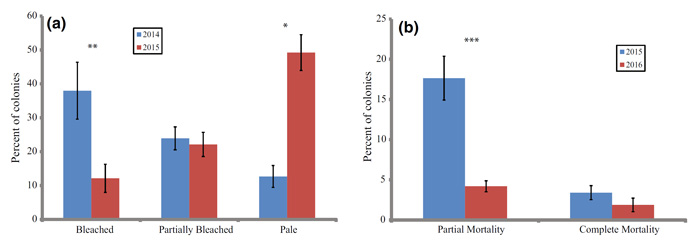| Tweet | Follow @co2science |
Paper Reviewed
Gintert, B.E., Manzello, D.P., Enochs, I.C., Kolodziej, G., Carlton, R., Gleason, A.C.R. and Gracias, N. 2018. Marked annual coral bleaching resilience of an inshore patch reef in the Florida Keys: A nugget of hope, aberrance, or last man standing? Coral Reefs 37: 533-547.
One of the most frequently cited causes of coral bleaching -- the phenomenon that describes the breakdown of the symbiosis between algal symbionts and their coral hosts -- is anomalously high water temperature. If elevated temperatures become too severe or persist for an unusually long length of time, coral bleaching can become irreversible and coral mortality can occur. Not surprisingly, therefore, there are concerns that if the world warms as predicted by current climate models, mass coral bleaching and death will ensue.
But just how certain is such a fate? Probably not too convincing.
Consider, for example, the fact that global temperatures have been quite stable over the past two decades, failing to rise in the manner predicted by climate models. This suggests that model projections of future temperature are unrealistically too high. What is more, a number of studies have demonstrated that corals, as living organisms, can acclimatize and adapt to rising sea temperatures, reducing their likelihood of bleaching from one severely elevated temperature episode to another (see the many studies we have reviewed on this topic under the heading Coral Reefs (Bleaching: Responses to Temperature Stress) found on this page). The latest work to demonstrate this recovery and resilience was published by Gintert et al. (2018).
For the period 2012-2016, this team of seven researchers reviewed thousands of high-resolution photographic images of over 4000 coral colonies at Cheeca Rocks, a shallow inshore patch reef in the Florida Keys, offshore of Islamorada, Florida, USA. In 2014 and 2015 summer temperatures on the Florida Keys were the warmest on record, resulting in two consecutive years of coral bleaching events. Consequently, these events, and the ongoing digital monitoring of the coral colonies, provided the scientists with the opportunity to examine the coral communities' responses to these unprecedented thermal stress events.
So what did their examination reveal?
Despite a more severe thermal stress event in 2015, the degree and severity of bleaching among the coral colonies was much less than that observed in 2014 (see Figure 1). In 2014, for example, 38.0% of corals bleached. By contrast, in 2015 that number reached only 12.1%, or more than a factor of 3 times less despite 2015 experiencing a higher accumulation of elevated temperatures.
Partial and complete mortality also decreased from one event to the other, with the former dropping from 17.6% in 2014 to 4.3% in 2015 and the latter declining from 3.4 to 1.9% between years.
In discussing their findings, Gintert et al. say that "the reduction in bleaching severity and coral mortality associated with a second stronger thermal anomaly provides evidence that the response of Caribbean coral communities to annual bleaching is not strictly temperature dose dependent and that acclimatization responses may be possible even with short recovery periods." And that should be welcome news to those who fret the future of these key marine organisms.

Figure 1. Percent of all coral colonies that were bleached, partially bleached, or pale in 2014 and 2015 (Panel a) and percent of colonies that exhibited partial and complete mortality in 2015 and 2016 (Panel b). Significance levels: * = p < 0.05; ** = p < 0.01; *** = p < 0.001. Source: Gintert et al. (2018).




